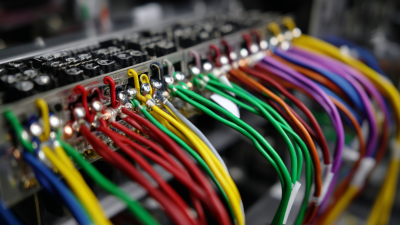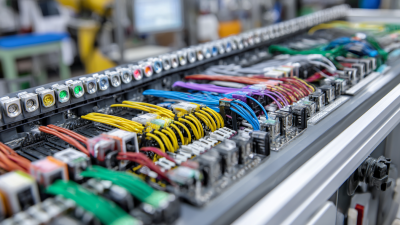What Is the Future of Wire Harness Manufacturing Equipment
The future of wire harness manufacturing equipment is poised for significant transformation driven by advancements in technology and increasing demand across various sectors such as automotive, aerospace, and consumer electronics. According to a recent report by Allied Market Research, the global wire harness market is projected to reach $66.9 billion by 2026, growing at a compound annual growth rate (CAGR) of 6.3% from 2019 to 2026. This growth underscores the critical role of efficient manufacturing processes and cutting-edge equipment in meeting the rising production needs. Innovations such as automation, smart manufacturing, and industry 4.0 technologies are becoming integral to wire harness manufacturing equipment. As manufacturers seek to enhance their capabilities and reduce costs, understanding these trends will not only influence operational efficiency but also shape the future landscape of the industry, setting the foundation for sustainable growth and advanced production techniques.

The Evolution of Wire Harness Manufacturing: Key Trends and Innovations
 The evolution of wire harness manufacturing is marked by significant trends and innovations that are shaping the industry's future. One of the most notable advancements is the integration of automation and smart technologies, which enhances precision and efficiency in production processes. Manufacturers are increasingly adopting robotics and AI-driven systems that not only streamline operations but also reduce labor costs. This shift enables companies to meet growing demands for customization while maintaining high quality standards.
The evolution of wire harness manufacturing is marked by significant trends and innovations that are shaping the industry's future. One of the most notable advancements is the integration of automation and smart technologies, which enhances precision and efficiency in production processes. Manufacturers are increasingly adopting robotics and AI-driven systems that not only streamline operations but also reduce labor costs. This shift enables companies to meet growing demands for customization while maintaining high quality standards.
Tip: Consider investing in modular manufacturing equipment that can easily adapt to varying production needs. This flexibility allows businesses to respond swiftly to market changes and technological advancements.
Another key trend is the emphasis on sustainable practices within the wire harness industry. Manufacturers are now exploring eco-friendly materials and processes to minimize their environmental impact. Innovations in biodegradable polymers and energy-efficient production methods are becoming more prevalent, providing companies with a competitive edge as consumers increasingly prioritize sustainability.
Tip: Regularly reviewing and updating your manufacturing processes to include sustainable practices can not only improve your brand image but also attract environmentally conscious clients.
Market Analysis: Growth Projections and Demand for Wire Harness Solutions
The wire harness manufacturing sector is poised for significant growth, driven by the increasing demand for advanced electrical systems in various industries. As industries such as automotive, aerospace, and telecommunications continue to evolve, the need for reliable and efficient wire harness solutions has never been more critical. Market analysis indicates a robust expansion trajectory, fueled by technological advancements and the rising complexity of electronic systems.
Moreover, the surge in electric vehicle production and the integration of smart technologies in everyday products are key factors propelling demand. Manufacturers are focusing on innovative equipment designed to enhance production efficiency, precision, and customization. As companies strive to meet these evolving demands, investing in advanced manufacturing equipment becomes essential, ensuring they can deliver high-quality wire harnesses that meet the needs of a rapidly changing market landscape. This growth not only reflects the increasing reliance on wire harnesses but also highlights the importance of innovation in maintaining competitiveness in the industry.
Future Projections of Wire Harness Manufacturing Equipment
Key Technologies Shaping the Future of Wire Harness Manufacturing Equipment
The future of wire harness manufacturing equipment is being molded by several key technologies that promise to enhance efficiency, precision, and adaptability in production processes. Industry reports indicate that the global wire harness market is expected to grow at a CAGR of 6.2% between 2021 and 2026, driven by increasing demand for electric vehicles and advanced electronics. As manufacturers seek to streamline operations, automated machinery and advanced robotics are becoming integral, reducing both lead times and labor costs while ensuring high-quality outputs.
Additionally, the incorporation of IoT (Internet of Things) technology is transforming traditional manufacturing into smart manufacturing landscapes. IoT-enabled devices provide real-time data analytics, allowing manufacturers to monitor equipment performance, predict maintenance needs, and optimize production schedules. According to a recent study by Grand View Research, the IoT in manufacturing is projected to reach USD 323.6 billion by 2027, underscoring its significant impact on the future landscape of manufacturing, including wire harness production. As these technologies evolve, the wire harness manufacturing sector is set to embrace innovative solutions that enhance both productivity and competitive advantage.
Challenges in Wire Harness Production: Addressing Quality and Efficiency
The wire harness manufacturing industry faces significant challenges in production quality and efficiency as the demand for advanced automotive technologies rises. One of the primary issues is the complex nature of wire harness design, which often involves intricate connections and varying tolerances. To overcome these challenges, manufacturers are increasingly turning to automation and digital tools. The integration of collaborative robots during the assembly process is becoming a game-changer, enhancing precision and reducing human error, thus ensuring better overall quality.
Moreover, the adoption of artificial intelligence in manufacturing environments is revolutionizing production efficiency. Automakers that have invested in digital solutions over the years are now reaping the benefits, producing wire harnesses faster and with greater accuracy. AI algorithms can analyze production data in real-time, allowing for quick adjustments and optimizations on the shop floor. As these technologies continue to evolve, the potential for improved quality control within wire harness production looks promising, ultimately setting new standards in the industry.
What Is the Future of Wire Harness Manufacturing Equipment - Challenges in Wire Harness Production: Addressing Quality and Efficiency
| Challenge | Description | Impact on Efficiency | Solutions |
|---|---|---|---|
| Quality Control | Ensuring defects are minimized in wire harness production. | High - Poor quality leads to rework and increased costs. | Implement automated inspection systems. |
| Labor Shortages | Difficulty in finding skilled workers to operate complex machinery. | Moderate - Affects production capacity. | Invest in training programs and automation. |
| Technological Advances | Keeping up with rapid technological changes in manufacturing processes. | High - Can lead to obsolescence of equipment. | Adopt flexible manufacturing systems. |
| Supply Chain Disruptions | Challenges in sourcing raw materials in a timely manner. | High - Leads to delays in production schedules. | Diversify supplier base and implement inventory management solutions. |
Sustainability in Wire Harness Manufacturing: Eco-Friendly Practices and Equipment
As the wire harness manufacturing industry moves towards a more sustainable future, integrating eco-friendly practices and equipment becomes paramount. Recent studies indicate that adopting sustainable manufacturing processes can lead to significant reductions in energy consumption and waste generation. For instance, implementing energy-efficient machines can lower operational energy use by up to 30%, while enhancing production efficiency. The use of recyclable materials in components can also aid in minimizing the environmental footprint, aligning with current sustainability goals that prioritize responsible sourcing and waste management.
Moreover, digital technologies, including artificial intelligence (AI) and machine learning (ML), are transforming the landscape of wire harness manufacturing. These technologies not only optimize production workflows but also facilitate the development of sustainable practices. AI-driven data analytics can predict equipment failures, reducing downtime and resource waste. According to research, companies employing smart manufacturing solutions can achieve a 20% decrease in material waste through better inventory management and predictive maintenance. By harnessing these advancements, the wire harness manufacturing sector can enhance its sustainability efforts, paving the way for a more responsible and eco-friendly future.

Related Posts
-

Challenges Faced in Cable Harness Design Efficiency
-

The Definitive Ultimate Guide to Mastering Wire Harness Assembly for Optimal Performance
-

Explore Superior Wire Harness Assembly Solutions from Leading Chinese Manufacturers
-

The Ultimate Guide to Streamlining Your Harness Assembly Process for Maximum Efficiency
-

Innovative Applications of Molded Cable Assemblies Across Various Industries
-

Essential Harness Assembly Checklist for Streamlined Production Efficiency